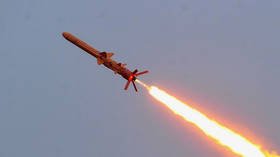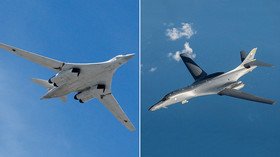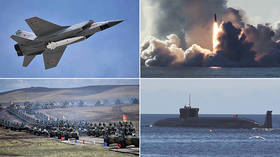Ukraine's new Neptune cruise missile is far from being God of Sea

Ukraine's new cruise missile, the Neptune, widely promoted by Kiev, is nothing but 'a lightly-modernized variant' of the Russian-made Kh-35 anti-ship missile, writes the National Interest. But that's not the only issue with it.
First, let's take a look at the missile at question. The Neptune is a Ukrainian subsonic low-altitude anti-ship missile designed to destroy vessels with a displacement of up to 5,000 tons, as well as hit ground targets. The Neptune – developed by Ukrainian manufacturer Luch Design - can be launched from ships, coastal missile systems and combat aircraft.
Ukraine's Navy plans to use the anti-ship missile as the primary weapon of its promising Vespa missile boats. However, the construction of the actual craft to carry the missile is still at the planning stage. The Neptune was unveiled at the international Arms and Security exhibition in Kiev back in 2015, and was created based on the designs of the Soviet Kh-35 anti-ship missile. The initial tests were conducted on March 22, 2016.
According to the National Interest, an American magazine, the missile has a range of just under 300 km and is equipped with a 150-kilogram high-explosive fragmentation warhead. With a cruising speed of Mach 0.8 to Mach 0.85, the Neptune also boasts a new inertial guidance system and active radar seeking.
Kiev believes that the cruise missile can provide Ukraine with a deterrent against Russia in the Sea of Azov, the magazine writes.
But how well does the Neptune meet the requirements of modern-day warfare? The Neptune being a 'reincarnation' of the Kh-35 does not require any further discussion. It is an indisputable fact, and there is no need to go looking for a Soviet 'fingerprint' in Ukraine's new weapon – the link is far too obvious.
There is, however, a number of other facts to look at and interesting conclusions to be made. In Soviet times, the Kh-35 was never really at the center of attention. Back then, the country prioritized the development of cruise missiles that could sink a nuclear-powered strike carrier. In this context, the Kh-35 looked modest, if not harmless. The missile was clearly unsuitable for use against enemy aircraft carriers, and the principal 'commissioner' – the Soviet Navy, that is – was less enthusiastic about sinking all other enemy ships, which could well be achieved with the Kh-35.
In fact, the Kh-35 was a kind of a counterpart to the US Harpoon anti-ship missile, developed in the late 1960s and early 1970s. The Soviet missile was conceived and created around the same period. The missile was a result of the technological achievements of the 1970s – which means that restarting its production would be a relatively easy task for modern Ukraine.
Today, this type of missile does not represent any serious achievement in the field of guided weapons, and neither is it a technological breakthrough of any kind. By its characteristics, it is significantly inferior to modern Russian missiles of a similar class.
Moreover, this missile is optimized for cost-effectiveness rather than for combat capabilities. By its very design, it is relatively easy-to-make and inexpensive. This is the reason why the navies of so many countries in the world keep similar missiles in service – examples would include France's Exocet missiles and the aforementioned Harpoon missiles (even in its earliest iterations). One could say that the Kh-35 fills its niche on the market as a tool that has a number of combat applications.
It should be noted though that anti-air defense on modern warships is extremely robust, multi-layered and effective. It could easily shoot down a missile like the Neptune, and do so from afar, without much effort or any cunning tactical maneuvers.
In other words, first-rate naval forces of the world – which are not known to cut corners in order to save a buck or two – would consider a missile like this neither a threat nor a useful investment. Things like higher cruising speed are much more in demand today.
The thing is, the Kh-35-type missile has a lot of other potential uses – and in this respect it could well remain viable for at least fifty more years. One could easily imagine a hypothetical scenario in which, say, a missile boat of one state opens fire on a cargo ship of a different state and hits it, successfully completing a combat operation. Besides, it would be unreasonable and wasteful to use a heavy anti-ship missile (which costs at about $5 million) to achieve the same goal.
That is why the Kh-35 and its alternatives remain a sort of a mass consumer product on the modern anti-ship weapons market. They do not possess remarkable speed, have no stealth capabilities and are not equipped with any fancy tactical system that allows a swarm of missiles to link up with one another and change formation depending on the situation.
In other words, the Kh-35-type missiles are a fairly simple design, which is why Ukraine's technological expertise is more than enough to start its mass production. This part is quite obvious.
The question is, though, what kind of targets is Kiev going to aim at? If it intends to fire at a warship or a detachment of warships equipped with modern anti-air systems, then the effect would be, obviously, close to nil.
Then again, exactly what is Ukraine going to use as a platform to launch its Neptune missiles from? At the moment, Kiev has no ships capable of carrying a missile launcher of this class.
One could consider the possibility of Ukraine using its aircraft as carriers for the missiles, but that leads to the issue of having to integrate an anti-ship missile system into a Ukrainian plane. To say this task would be difficult is an understatement. Also, it is not clear which types of Ukrainian planes can even house a missile like that. Basically, Kiev would have to carry out a whole new research and development project. This, in turn, opens up another set of issues. For example, Ukraine currently does not have any aircraft with an open avionics architecture. This means that Kiev would have to significantly alter the design of the prospective carrier.
At this point, it should be noted that there is not a single type of aircraft without an open avionics architecture that has had a Kh-35 missile integrated into it. Of course, it is theoretically possible to rig the aircraft with the missile system in some primitive, crude way, without connecting it to the onboard radar.
But that would raise yet another issue: what distance from the target would allow for an effective launch of the missile in a combat situation? In this case, the carrier aircraft would have to get so close to the target ship that it might lead to visual detection. If that happens, the aircraft could be easily destroyed by the ship's anti-air system. Which leads us back to the question – what is the point of having this type of an anti-ship missile?
That is not to say that, as a missile, the Neptune would be useless. However, when marketed as a complete and operational weapons system that would create some fundamentally new opportunities for Ukraine's armed forces, it looks severely underwhelming.
As a ground-based missile system, the Neptune could still be used in counter-amphibious assault operations, preventing the enemy from landing on Ukrainian shores. And this is something the potential adversary would have to take into account. But in terms of naval operations, one could hardly imagine a use for the Neptune right now.
That said, in this day and age Kiev prefers not to formulate any meaningful answers. Or analyze any problems. Or even raise these sorts of questions.
Think your friends would be interested? Share this story!
The statements, views and opinions expressed in this column are solely those of the author and do not necessarily represent those of RT.
















